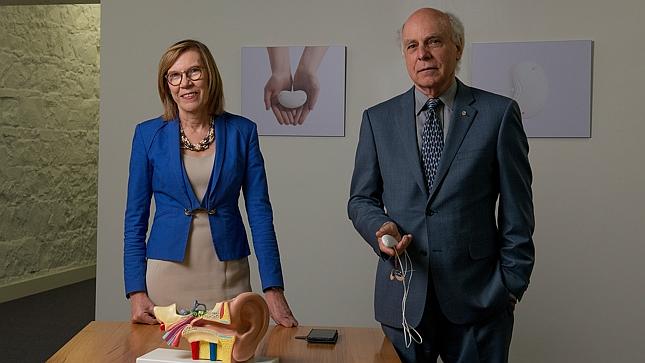Using Modern Technology to Help Hearing
It is good to see that modern technologies are being adapted to assist people with disabilities. I came across this today and thought how marvellous it would be if this or similar technology could be used assist those who have not been able to access this type of audio assist.

The hearing aid entrepreneurs whom audiologists hate
Published in BRW 20 March 2015 Larissa Nicholson
“Disrupting a cosy, overpriced industry”: customer-fitted hearing aid pioneers Dr Elaine Saunders and Professor Peter Blamey
A hearing aid package which eliminates the need to visit a specialist has not endeared the entrepreneurs behind it to their audiologist peers.
But Dr Elaine Saunders and Professor Peter Blamey say positive feedback from clients who previously could not afford to address their hearing problems makes up for the criticism.
Both respected scientists in their own right, Saunders and Blamey are the Melbourne team behind IHearYou: a system which allows ordinary people to test their own hearing, buy hearing aids online and adjust them to get them working in the best possible way, all without visiting a specialist.
“In Australia, more than four million people have hearing loss and most don’t do anything about it because of prohibitive costs, distance from services and perceived stigma. Unfortunately, untreated hearing loss often leads to physical, cognitive and mental health complications,” says Saunders, herself a trained audiologist.
“IHearYou removes these cost and distance barriers. We’re disrupting a cosy, overpriced industry. And we are working hard to address the social stigma.”
Available online and in their Melbourne Blamey Saunders Hears shopfront, the IHearYou-supported hearing aids make use of bionic ear technology, which their inventors claim is not always utilised in other options within the same price bracket – about $2250 a pair for the basic model, and $3675 for the more advanced.
The programming system means that for many users, getting the sound right in their hearing aids could be as simple as listening to four different chimes on their PC, then adjusting their volume so they all sounded the same, Saunders says.
All the company’s research and design is done in Melbourne. Its hearing aids were designed by freelance medical jewellery specialist Leah Heiss (although they are manufactured in Thailand) while BRW Most Innovative company Planet Innovation collaborated to design the latest IHearYou system, which incorporates a smartphone app and a Bluetooth-enabled programmer. (The collaboration has been entered in the 2015 Good Design Awards.)
Blamey Saunders Hears has a team of experts that users can call or visit for support. Some are audiologists, but the company has drawn customer support staff from a variety of professions, because Saunders points out “there is no such thing as a trained telehealth audiologist in Australia”. Occupational therapists and classically trained musicians are among those available to help customers optimise their hearing aids.
However the majority of customers have not needed to, Saunders says, saving time and money that might otherwise have been spent on visits to medical specialists.
Broadcaster Phillip Adams is a fan, providing a testimonial for the Blamey Saunders Hears website explaining that after trying out hearing aids which had cost more than $10,000, he liked the IHearYou basic model best.
But IHearYou has its critics, many of them audiologists.
Dr Saunders recalls being asked point blank by one such professional what it was like being hated by her peers.
Her response was that she knew of many hearing aid users who felt differently.
Professor Blamey says technology is changing the delivery of health services in a way some professionals found challenging.
“It’s one of the examples of e-health that enables clients to look after themselves, with access to help when they need it,” he says.
No doubt some audiologists were concerned for their livelihoods, Saunders says, but she points out that she too employs hearing professionals.
Efficiencies from in the Blamey Saunders Hears model would give audiologists more time to work face-to-face with patients who need that kind of attention, she says.
Peak body Audiology Australia refused to speak directly on the impact of the Blamey Saunders model on hearing industry, saying it did not comment on individual businesses or devices.
But it did provide a statement saying helping patients fix communication problems caused from hearing loss required the appropriate prescription and fitting of a hearing prosthetic, followed by appropriate rehabilitation support and services.
It said some audiological processes could and were being provided for clients through internet-based approaches, which involved the client in some procedures.
But that should be done under audiological management, to ensure that medical conditions that could be threatening to the health of the individual are appropriately detected and referred for medical management.
Whether IHearYou’s hands-off approach satisfied the organisation’s requirement of “audiological management” for the safety of clients is unclear.
Saunders says all patients were encouraged to visit their GP to check for any underlying medical problems before they started using their hearing aids.
Still a sub-$10 million turnover company, Saunders has Blamey Saunders has sold “many thousands” of pairs of its IHearYou-enabled hearing aids since the self-fitting system first launched in 2011. However she hoped the new smartphone-enabled interface designed by Planet Innovation would eventually help her company sell globally, provided sufficient customer support could be provided in new territories.
Additional reporting by Michael Bailey
